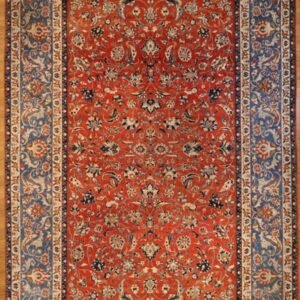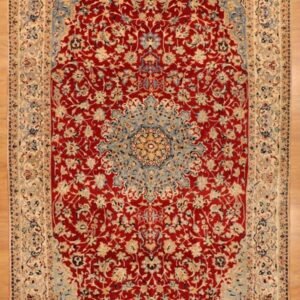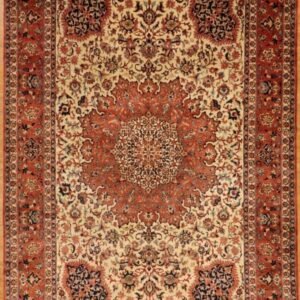Serial No.: 0009748
Origin: Bidjow, Kuba, Caucasian
Age: Early 20th Century
Style: Tribal Size: 5’5’’ x 5’9’’
Material: Wool Foundation, Wool Pile, Vegetable Dyes
Color Scheme: Red, Ivory , Salmon, Green, Black, Navy
Expert Description: Early 20th-Century Bidjov Sumak Weaving
Provenance & Cultural Context
Originating from Bidjov in the Kuba district of the Caucasus, this early 20th-century textile exemplifies the region’s storied heritage in tribal weaving traditions. The Kuba area, situated in northeastern Azerbaijan, is renowned for producing high-quality rugs and flatweaves, each distinguished by intricate patterns and vibrant natural dyes. Bidjov itself is noted in rug scholarship for its characteristic design language, often featuring bold tribal motifs and well-defined color contrasts that mirror the broader Kuba aesthetic.
Sumak Weaving vs. Traditional Pile Rugs
Unlike typical pile rugs, which employ knotting techniques to produce a plush surface, sumak (or soumak) is a form of flat-weave that involves wrapping weft threads around groups of warp threads. In practical terms, this means:
- Pile Weaving: Each knot is tied individually onto the warp to create a raised, tufted surface. The result is a thick, cushioned texture.
- Sumak (Soumak) Technique: The weaver wraps colored weft threads over and under the warps, creating a flat or slightly raised tapestry-like appearance without the plushness of knotted pile. This approach allows for precise geometric patterns and is more time-intensive, reflecting the weaver’s artistry and technical prowess.
Design & Color Scheme
Measuring 5’5” x 5’9”, this piece employs a dynamic palette of burgundy, ivory, salmon, green, black, and navy, all derived from vegetable-based dyes. The central field showcases a series of stylized tribal motifs—possibly abstracted fauna or protective symbols—arranged in a manner that suggests rhythmic repetition. A multi-tiered border system frames the center, incorporating geometric guard stripes and larger-scale motifs reminiscent of classic Caucasian designs. The interplay of bold burgundy and complementary accent hues (like salmon and green) underscores the region’s inclination toward rich contrasts and symmetrical composition.
Weaving & Dyeing Processes
The foundation (warp and weft) is wool, a staple material in the Caucasus for centuries due to its abundance and natural resilience. In sumak weaving, additional weft threads are meticulously wrapped around the warp in discontinuous sections to form the intricate patterns. This technique is labor-intensive, often resulting in a tighter weave and a flat or slightly embossed surface. The vegetable dyes—sourced from local plants, minerals, and insect extracts—yield nuanced color gradations and a subtle “abrash,” reflecting the artisanal dyeing process. Over time, these natural pigments develop a gentle patina, which collectors value for its authenticity and organic beauty.
Hints from the Era & Usage
In the early 20th century, as Caucasian weaving communities encountered growing external demand, sumak pieces like this one remained steadfast in reflecting indigenous tastes and practical needs. They often served dual roles: functional floor coverings and symbolic artifacts in communal or domestic spaces. In modern interiors, their robust construction and decorative flair open up various possibilities:
- Floor Accent: Placed in a living room or study, it adds both texture and historical resonance.
- Wall Hanging: Due to its flatter profile and visually intricate design, a sumak textile is particularly suitable for vertical display, transforming a blank wall into a cultural statement.
- Entry or Alcove Highlight: Its moderate dimensions make it ideal for smaller areas where the full pattern can be appreciated.
This Bidjov sumak weaving not only embodies the technical finesse and rich dyeing heritage of the Kuba district but also stands as a vibrant testament to the artistry of Caucasian tribal traditions. Its fusion of flat-weave technique, natural colorants, and cultural symbolism renders it an invaluable piece for collectors and admirers of historic textiles alike.







Reviews
There are no reviews yet.